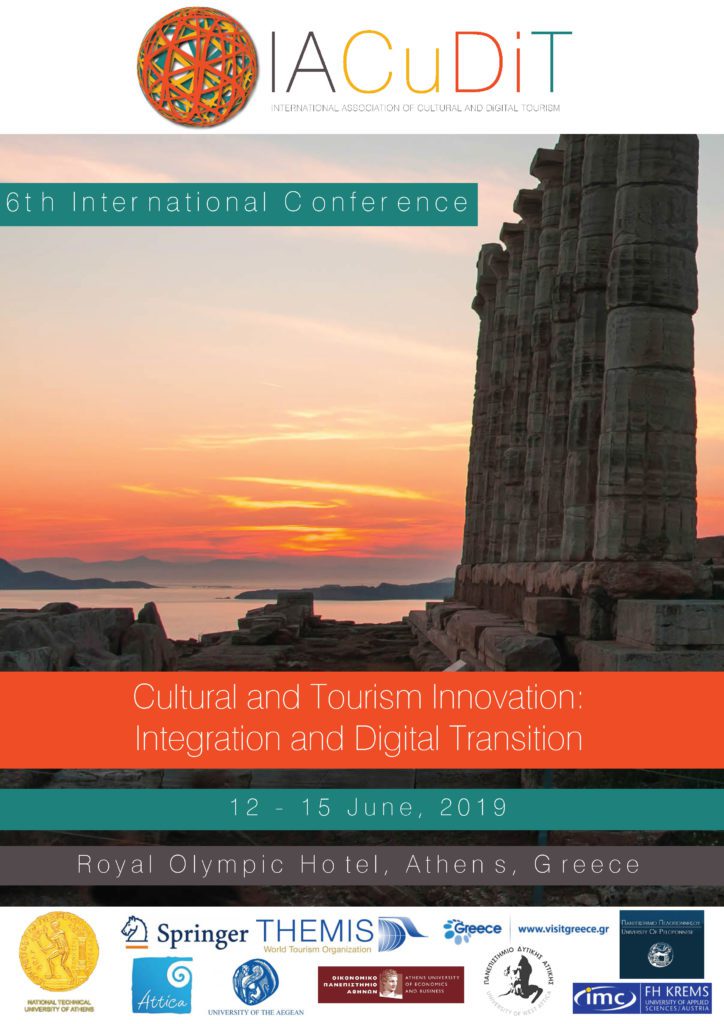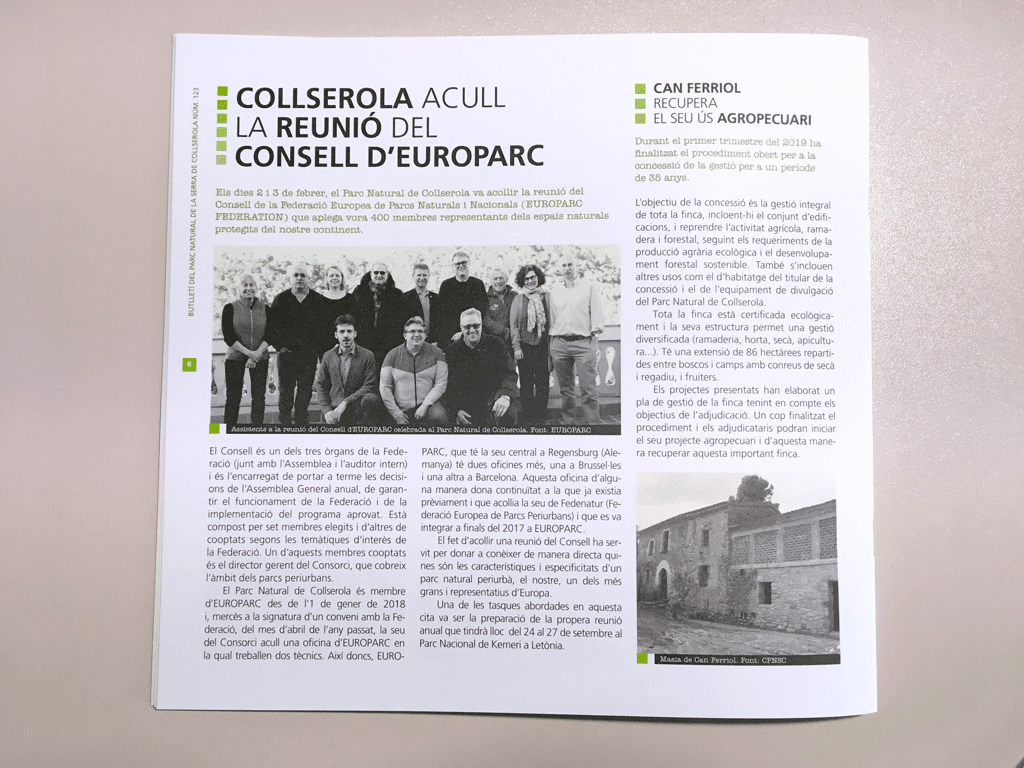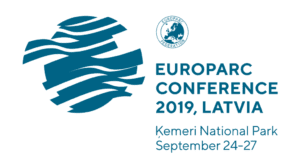International Conference “Cultural and Tourism Innovation: Integration and Digital Transition”
6th International Conference of the International Association of Cultural and Digital Tourism will take place from June 12 – 15, 2019, in Athens, Greece with the theme “Cultural and Tourism Innovation: Integration and Digital Transition”.
The aim of this conference is to promote constructive, critical and interdisciplinary conversations on the challenges emerging in tourism from the digital transformation of the industry by bringing together researchers, communities, industry and government stakeholders. In line with the values embedded in the UNWTO goals, the conference will address digital advances and innovation as part of the solution to the challenge of marrying continued growth with a more inclusive, sustainable and responsible tourism sector.
A dedicated conference track is open to relevant final year doctoral researchers in order to share their research experience, disseminate their findings and present their contribution to theory and practice.
Please visit http://iacudit.org/Conference2019

CFP 2019 brochure
You can find conference topics, registration fees and other information here!
EUROPARC calls for action to the new EU Parliament.
Yorkshire Dales kaarst - Photo by Hilary Fenten
Next May 23rd to 26th of the present year, Brussels will become again the centre of attention of all Europeans. During these days, the European elections will take place allowing millions of European citizens to decide who will be steering the route of the EU during the following five years.
These elections may have significant changes not only in the composition of the EU Parliament and Commissioners board, but also in the institutions in charge of setting the strategy that our continent will follow. Among the citizenship concerns, the environment, and specially climate change, occupy a top place in the list.
For this reason, and in the previous month to the elections, EUROPARC Federation is raising the voice to our natural heritage with the publication of the Policy Paper “Our Natural Heritage: the Key to Europe’s Future”.
This document aims to mobilise European Political Groups, National Parties and Movements, as well as individual candidates, to take action on different topics in order to ensure a sustainable future for our economy and our environment. One of the matters stressed in the document is the role that Protected Areas must have in achieving substantial changes related with the environment and socio-economic development, and it also identifies four priority areas which require urgent attention and action:
- sustainable economic development;
- healthy ecosystems;
- youth leadership;
- climate change.
Despite the great efforts that the European Union has made in the previous years to address the environmental challenges that our planet is facing through the establishment of specific legislation and actions, still further development and more effective implementation is required.
For further information on European Policies and the work of the Federation in this regard, visit the EUROPARC Policy webpage.
Collserola Nature Park hosts EUROPARC Council Meeting
From February 13th to 15th, Collserola Nature Park hosted one of the EUROPARC Federation´s Council. This organ carries out its function together with the president, Ignace Schops, and the internal auditor, Roger de Freitas.
The Council is in charge of granting the correct functioning of the Federation and implementation of the approved programme and strategy. It is composed by twelve members, from which nine of them are elected every three years by EUROPARC members and three of them are assigned by existing Council members (co-opted members) according to their expertise. Among them, the manager of the Collserola Nature Park Consortium, Marià Martí, representing Periurban Parks and also chair of the Periurban Commission of EUROPARC.

Collserola Nature Park spring bulletin, with a dedicated article to EUROPARC Council meeting – Photo by EUROPARC Federation.
Since 2018, Collserola nature Park has been a member of EUROPARC Federation and, throughout an agreement reached with EUROPARC Federation in April of that same year, it hosts one of the three offices of EUROPARC Federation in Europe with two technicians working in it. The Barcelona office of EUROPARC Federation, hence, gives continuity to the former office of the European Association of Periurban Parks – Fedenatur, which was integrated into EUROPARC at the end of 2017.
Apart from serving as a venue, hosting one of EUROPARC Federation´s Council meetings in this park has also given the opportunity to the Councillors to get a deeper knowledge on the features of this park, one of the greatest examples of Periurban parks in Europe.
One of the tasks covered during the meeting was the preparation of the following EUROPARC Conference, the gathering of protected area managers that EUROPARC Federation organises every year in different regions of Europe once a year, which will take place in Kemeri National Park, Latvia, from September 24th to 27th 2019.

EUROPARC Conference 2019 banner
Next Webinar: Large Carnivores in Transboundary Parks
Large Carnivores in Transboundary Parks
- 16th April 2019
- 11:30 CEST
- Register here
During centuries, European large carnivores (including the brown bear, wolf, lynx and wolverine) suffered dramatic declines in numbers and distribution. Human activity, habitat loss and the decrease of prey, pushed these species to the very remote areas of Europe. However, the situation is shifting. Due to the improvement of habitat conditions and prey availability, backed by protective legislation in many European countries, the populations of large carnivores are stable or indeed growing.
The predatory nature of these species has pushed them to trespass the political boundaries established by humans in the search for better conditions to thrive.
In fact, nature knows no borders, and the expansion of the populations in new areas might trigger conflicts and the establishment of control measures that might compromise their existence. With the presence of large carnivores increasingly more common, “we need to learn how to coexist!”
To start with, the collection of reliable scientific data, the provision of relevant population estimates, and a common understanding of large carnivore’s conservation status at national and population level is the basis to make sound management decisions.
Why transboundary cooperation is needed
Large carnivore’s home range is extensive, and as such, they require large areas to live. These areas often cross intra and international borders and occupy territories with different management policies. The management of these species must be planned on very wide spatial scales to be effective, and it is imperative that a good coordination exists between the different administrations involved.
Within the network of EUROPARC Transboundary Parks, there are several examples of cooperative work for the monitoring some of these species. In this webinar, we will hear from 2 Transboundary Areas how they are jointly working for monitoring the Eurasian lynx and the brown bear populations and will get insight from FACE – the European Federation for Hunting and Conservation – about their monitoring system in Scandinavia.
This webinar is a joint organisation with the EU Platform on Coexistence of Large Carnivores and People. Together we seek to find ways to mitigate conflicts between people and large carnivores and promote successful measures of coexisting. More information on the EU Platform can be found on the website
Participation is free, but registration is needed! All participants are most welcome to share their views and direct their questions to the presenters. After the presentations, there will be a live Q&A.
Case Study 1) Transboundary research on the ecology of Eurasian lynx and its ungulate prey
by Ludek Bufka, Šumava National Park (CZ)
In the Bohemian Forest Ecosystem (BFE) as in most of Europe, lynx became extinct in the 19th century and nowadays’ “Bohemian-Bavarian-Austrian” lynx population originated from a relatively small number of animals that were reintroduced in the 1970s (Germany) and 1980s (Czech Republic), in the area which is now covered by the Bavarian Forest and Šumava National Parks.
At present, this lynx population is stagnant and this is mainly caused by high, mostly anthropogenic mortality outside of protected areas (traffic, poaching). Outside of protected areas lynx are often persecuted due to competition with hunters for ungulate prey (namely roe deer and red deer), and bad attitudes towards the lynx are often caused by wrong „myths“ about their habits. Therefore, between 2005 and 2012 the park authorities set up a monitoring plan for lynxes, roe deer and red deer by means of GPS telemetry to create evidence-based knowledge about lynx time-space behaviour, predation and prey consumption rates.
Case Study 2) Non-invasive genetic monitoring of the Pasvik-Inari-Pechenga brown bear population using systematic hair-trapping
by Snorre Hagen, Norwegian Institute of Bioeconomy Research – NIBIO (NO)
The trans-border brown bear population of Pasvik-Inari-Pechenga (Norway-Finland-Russia) has been monitored using genetic analyses of faeces collection since 2005. In addition, in 2007, 2011, and 2015 hair traps were placed out in the area to collect hairs for genetic analysis.
The objective was to determine more precisely the minimum numbers of bears in the area, as hair-traps can be placed out systematically and are successful in sampling also more elusive and shy individuals, such as female bears. A trilateral hair trap methodology that will be repeated in 2019, using the exact same methodology as in 2007, 2011, and 2015, to make a direct comparison of the results from all the 4 study years, covering a time period of 12 years.
How to join?
Webinars are open not only to EUROPARC members – but to everyone with an interest in Protected Areas. Participation is free but registration is necessary. Register here.
You can join in from anywhere: you will just need a device with internet connection. EUROPARC webinars are held in English and participants have the chance to join the discussion with the invited speakers, at the final part of the webinar. NOTE: Please make sure you have the latest JAVA version, you can run a check to the webinar by following this link: https://gr3eq.wb.getresponse.com/room/connection-tester
